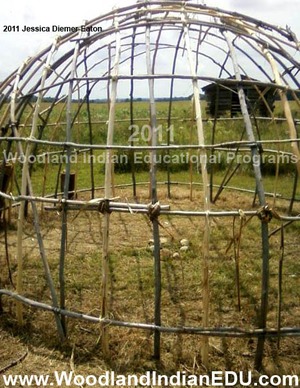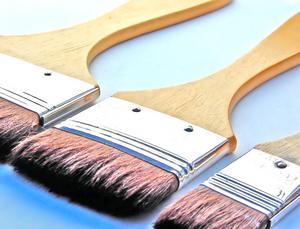Poles selected for Delaware house frames were obtained from hickory, chestnut, elm or other hardwood saplings (young trees). Wigwam/longhouse frame construction had to be done during the spring to summer seasons, when the saplings were much more flexible and able to bend into the desired domed shape. Saplings selected for the job of vertical posts in the framework had to be of a substantial size, around 2.5 inches in diameter at the base.
The saplings were stripped of their bark, and such thin bark was probably saved for cordage in securing the framework. Doing this added to the lifespan of the frame as bark would only hasten wood rot. Many times, the ends of the poles that were placed in the ground were fire hardened, which can help ward of ground level rotting and make it easier to thrust the posts into the hard soil.
The domed wigwam and longhouse frames were permanent, the footing ends plunged into the ground. While this could be accomplished by digging holes or trenches, archaeological evidence shows no or minimal ground disturbance around post hole stains suggesting that possibly a stake was forced into the ground to mold the holes, then the vertical frame poles were then thrust into the cavities measuring 12 to 18 inches deep. Each pole was usually placed 9 to 12 inches apart, with exception to the home’s entrance. One such example of a 20 x 60 foot Delaware cigar-shaped longhouse revealed a foundation of 220 postholes (double-frame).
Many woodland wigwam posts were set in the ground on a slight angle to the outside. This was done to create a higher ceiling when bending the saplings into their barrel roof shape, by bending opposite of the outward angle. If the poles are anchored straight in the ground, the pull of the bending might start the curve in the ceiling to low on the wall.
Saplings had to be used and bent within a day or so of being cut down; any longer and the dead trees would start to loose their flexibility and become more likely to break under the tension of bending the barrel roof. The vertical poles were bent inward to form the dome roof of the home. Most of these poles can be thought of as ribs; each sapling meets and ties to a twin anchored on the opposite wall.
Once all vertical posts were in place, horizontal poles were added. This added strength to the frame by creating a lattice. These frames had to be strong enough to carry several hundred pounds of bark, as well as a snow load. Cordage was used to secure the horizontal poles in place; finer cord being made from the inner layer of mature barks, and rougher strips from the entire bark of young trees (such as what was stripped off the framework poles).
Included in wigwam and longhouse framework construction were the sleeping platforms and upper shelves, made from saplings too. Evidence shows that some larger longhouses also had partitions that were framed with poles as well. Many Delaware homes also exhibit a second or outer framework, made in the same manner as the main framework with the objective to capture and compress the large bark sheets that covered the home (please refer to our online Yahoo article “The Traditional Coverings of Wigwams & Longhouses” by Jessica Diemer-Eaton).
Further Reading: “The Lenape-Delaware Indian Heritage” by Herbert C. Kraft


